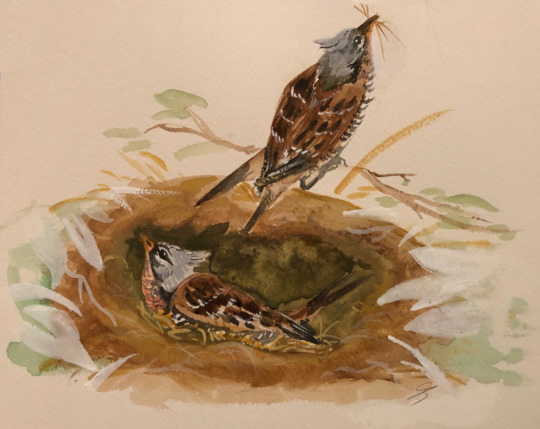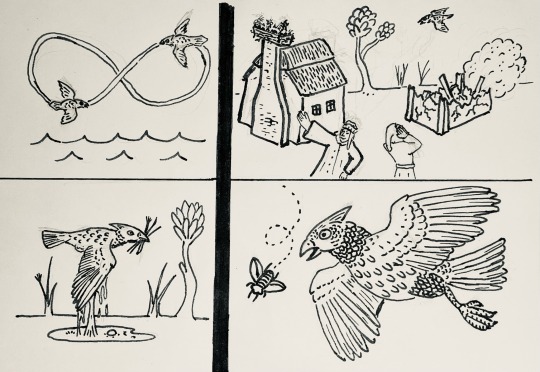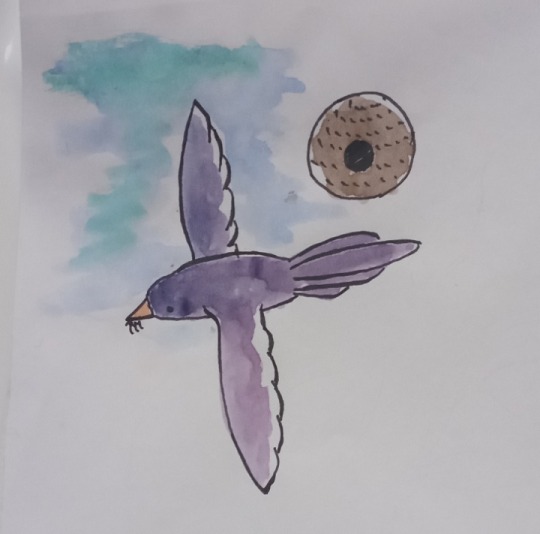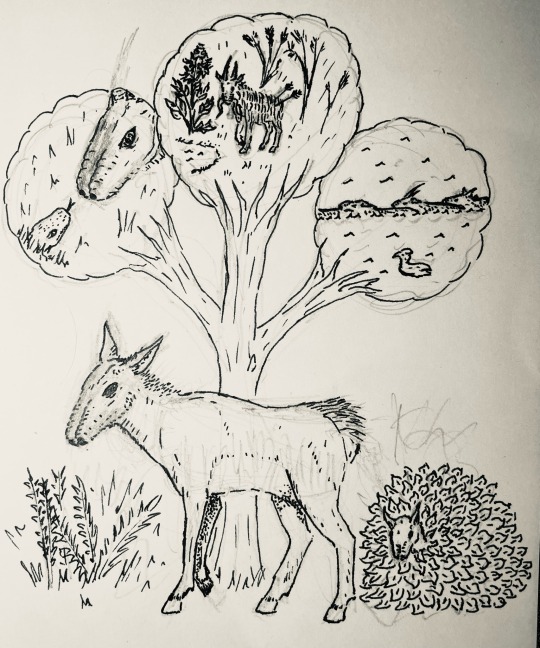#Yaggzrok
Text

I had some paint left over from another piece for class, and thought 'hey, two birds, one stone' and decided to do a quick watercolor painting of this week's bestiary posting critter. After like a year, I'm finally starting to get the hang of this whole watercolor thing.
This week's critter is the Yaggzrok. I have a pretty good idea what this one could be. It's always a bit of a challenge when you think you know it and are like 'well, I have to do something totally different that still fits the description'. Then again, my guess could be wrong, who knows.
Here I've drawn a male and female building their nest, which is not quite finished. The male even has a bit of the mud "slime" still on the tips of his wings.
The description calls this a "tiny" and "twittering bird", so I think a passerine bird is safe to assume. A small passerine bird is a good base to work off of - specifically a sparrow. Added a forked tail and short wings for maneuverability in the air, and a delicate beak for snatching insects out of the air. The crest is a reference to jays who share their smarts. For their nest I imagine it's similar to an overbird's and tried to replicate that. For coloration I used a fieldfare as inspiration, purely because I already had those colors mixed up for my other painting (thrushes are my bird-obsession this week). But as the bird is described as 'pious' I feel like browns, blacks, whites and greys are a good choice regardless.
20 notes
·
View notes
Text
The perspicacious Yaggzrok

My response to this week’s BestiaryPosting challenge, from @maniculum
I feel like I'm definitely getting better at drawing birds, but it's also making it much more obvious when I mess up the anatomy :D
Initial pencil sketch, then Sailor fude nib fountain pen with Rohrer & Klingner Sepia ink for the lines. I think I need to find a fine-nib fountain pen, and try drawing with that - the flexibility of the fude nib (in terms of thick/thin lines and being able to transition easily between them) is really nice, but for now being able to keep a consistent (and thin) line would benefit me more in terms of learning and practicing, particularly some of the tiny details I keep trying to include! :D
Reasoning under the cut...
Isidore says this about it: ‘The Yaggzrok is so called because it does not feed on the ground but catches its food and eats it in the air. It is a twittering bird that flies in twisting, turning loops and circuits, is highly skilled in building its nest and rearing its young, and has also a kind of foresight because it lets you know when buildings are about to fall by refusing to nest on their tops. In addition, it is not harassed by birds of prey nor is it ever their victim. It flies across the sea and winters there.’ -
So, we know this is a twittering bird that exhibits 'hawking' behaviour (eating on the wing), and that it nests on the top of buildings. How does it do that? Well, it's here that I start to have some suspicions about this creature's identity, so I start to backpedal furiously. Now, non-small birds that make their nests on houses? How about storks, nesting on chimney stacks? I'm not entirely sure how fire-safe the nest in the top-right illustration is, but maybe the smoke keeps parasites out?
We can also see that the canny Yaggzrok has been very smart about which house the nest was built on. The owner of the house marvels at his good fortune, while his neighbour... :(
The top left illustration shows the Yaggzrok flying in loops over a body of water.
The Yaggzrok is a tiny bird but of an eminently pious nature; lacking in everything, it constructs nests which are more valuable than gold because it builds them wisely. For the nest of wisdom is more precious than gold. And what is wiser than to have, as the Yaggzrok does, the capacity to fly where it likes and to entrust its nest and its young to the houses of men, where none will attack them. For there is something attractive in the way that the Yaggzrok accustoms its young from their earliest days to the company of people and keeps them safe from the attacks of hostile birds. -
It's a small bird, so nothing so magnificent as a raggfong, but we do know it's extremely skilled at constructing its nests (though I suspect 'more valuable than gold' might be pushing it). Again, it's reiterated that it builds nests on human houses - it you look *really* carefully you can see a couple of Yaggzrok chicks peeking out of their nest, waiting for a parent to return.
Then, remarkably, the Yaggzrok creates a regularly-proportioned home for itself without any assistance, like a skilled craftsman. For it gathers bits of straw in its mouth and smears them with mud so that they stick together; but because it cannot carry the mud in its claws, it dips the tips of its wings in water, so that dust sticks to them easily and turns into slime, with which to gather to itself bits of straw or tiny twigs, a few at a time, and makes them stick. It makes the whole fabric of the nest in this fashion, in order that its young can live safely as if on a solid floor in houses on the ground, lest any of them insert a foot between the small gaps in the woven fabric or the cold should get to the very young. -
More detail on the nests - a regularly proportioned home? A solid floor? Maybe the sharp angles in the corners of the nest are a little excessive, but they bring across the point!
In the bottom left, we can see a Yaggzrok gathering material for the next; straw in the mouth, ready to be smeared in mud, but more importantly, *slime* on the wings... :p
This conscientiousness is fairly common among most birds, yet what is distinctive about the Yaggzrok is its special loving care, shrewd intelligence and the extraordinary quality of its understanding. Then there is its skill in the arts of healing: if its young are infected by blindness or pricked in the eye, it has some kind of healing power with which it can restore their vision. -
At this point, I couldn't think of much to express this part of its behaviour, so I opted for a more detailed sketch of the Yaggzrok hawking (which also gave me an excuse to draw a medieval bug!).
In terms of general anatomy, I looked at flycatchers (small, hawking birds, some of which have a small crest), but dialled up the exageration to make it a little more distinctive. In terms of the overall structure and setup, I was influenced by @coolest-capybara's Raggfong illustration and the multiple panels, given that I wanted to express multiple different aspects of this bird's behaviour (I did it in a less narrative way though, which I might rethink if I try this structure again).
I also took some inspiration from this post that @coolest-capybara reblogged; my copy of M.S. Bodley 764 is still in mothballs while I'm following these challenges, so I'm trying to find some good resourses for medieval illustrations (houses was a real struggle!) without doing direct searches for animals and (potentially) getting spoiled...
17 notes
·
View notes
Text

And another set of birds for the Maniculum Bestiaryposting Challenge! This time, the Yaggzrog:
Finally, a bird where the author seems to have nothing to complain about. Instead, they are praised for their "foresight", "pious nature", skilled craftsmanship in building their homes and "skill in the arts of healing".
The inspirations and reasoning for my depiction can be found below the cut:
What could be more useful in constructing nests "more valuable than gold" than the ability to hover in the air? So I went with hummingbirds, with the added bonus of being able to direct their flight with swallow-like tails. I gave them very colorful plumage mostly because I discovered how much I like drawing rainbow birds in the last installment, the Fekthrud.
As inspiration for the medieval architecture, I referred to illustrations in the Liber Divinorum Operum by Hildegard of Bingen. Then I tried to illustrate some elements of the description that stood out to me:
Collecting mud on their wings to make their nest, which in this case, is being used to paint the decoration;
Catching their prey in the air, as shown by a bird feeding some sort of flying insect to the young;
Being conscientious craftsbirds - here, one of the birds is inspecting a crack in the wall;
Healing blindness in their young, which the last bird is doing.
#digital art#my art#maniculum bestiaryposting#yaggzrok#birds#hummingbird#rainbow#artists on tumblr#bestiary
10 notes
·
View notes
Text

Ended up using the American Black Swift, the Chimney Swift, the Scizzor-tailed Flycatcher, the Fork-Tailed Flycatcher, the Tree Swallow, and the Barn Swallow for references this time as it sounded like an insectivore that catches it's meals on the wing and nesting close to if not inside human buildings. I'm a sucker for pretty tails, thus the Flycatchers. Hands are still bugging me so I'm not getting into more detail with the behaviours mentioned this time.
10 notes
·
View notes
Text

Two weeks of chaos later and I'm back on the bestiary challenge
One yaggzrok, a migratory bird that eats on the wing and builds regular nests.
I tried hard not to let my suspicions of what these guys really are affect the design too much but there's only so much variety in a bird body plan so I think maybe it shows.
9 notes
·
View notes
Text
Bestiaryposting -- Yaggzrok
As a reminder, all previous entries in this series can be found at https://maniculum.tumblr.com/bestiaryposting .
Also, happy new year depending on which calendar you're using! If I was late posting the results from the last one, &c., &c., you saw this same thing last week.
Isidore says this about it: ‘The Yaggzrok is so called because it does not feed on the ground but catches its food and eats it in the air. It is a twittering bird that flies in twisting, turning loops and circuits, is highly skilled in building its nest and rearing its young, and has also a kind of foresight because it lets you know when buildings are about to fall by refusing to nest on their tops. In addition, it is not harassed by birds of prey nor is it ever their victim. It flies across the sea and winters there.'
The Yaggzrok is a tiny bird but of an eminently pious nature; lacking in everything, it constructs nests which are more valuable than gold because it builds them wisely. For the nest of wisdom is more precious than gold. And what is wiser than to have, as the Yaggzrok does, the capacity to fly where it likes and to entrust its nest and its young to the houses of men, where none will attack them. For there is something attractive in the way that the Yaggzrok accustoms its young from their earliest days to the company of people and keeps them safe from the attacks of hostile birds.
Then, remarkably, the Yaggzrok creates a regularly-proportioned home for itself without any assistance, like a skilled craftsman. For it gathers bits of straw in its mouth and smears them with mud so that they stick together; but because it cannot carry the mud in its claws, it dips the tips of its wings in water, so that dust sticks to them easily and turns into slime, with which to gather to itself bits of straw or tiny twigs, a few at a time, and makes them stick. It makes the whole fabric of the nest in this fashion, in order that its young can live safely as if on a solid floor in houses on the ground, lest any of them insert a foot between the small gaps in the woven fabric or the cold should get to the very young. This conscientiousness is fairly common among most birds, yet what is distinctive about the Yaggzrok is its special loving care, shrewd intelligence and the extraordinary quality of its understanding. Then there is its skill in the arts of healing: if its young are infected by blindness or pricked in the eye, it has some kind of healing power with which it can restore their vision.
Remember to tag posts with #Yaggzrok so folks can find them.
20 notes
·
View notes
Text
The ophiophagous Basekhwa
My response to this week’s BestiaryPosting challenge from @maniculum

Jinhao shark fountain pen with fine, hooded nib, with Monteverde Raven Noir ink, over initial pencil sketch. Previously I've always used a mechanical pencil for the initial sketch, but this time I figured I'd try something more artsy, 5.6ml HB lead in a n e+m clutch pencil. Much less precise, but nicer for drafting. I figure it's a good indicator I've gotten more confident in my inking linework compared to when I started!
One thing I'm really finding with these challenges is that I'm really learning the value of a good reference. It seems obvious typing this out, but the way I think something should look (in context, particular animals) and the way it actually looks can be quite different (case in point, the legs on ruminants!).
Reasoning below the cut;
So first things first, this is one of the longer more detailed descriptions we've had so far. There were so many different types of behaviour described here that I knew I wanted to cover as many as possible. I initially considered dividing the picture into quarters, as I had with the Yaggzrok (with maybe a fancier border). Maybe I was inspired by the fancy tree in the picture from the bestiary last week, but as I also wanted to give more space to a slightly larger picture of the creature, I had the thought of doing some smaller viginettes showing the different behaviour, hence the finished composition...
"Basekhwas are the enemies of snakes; when they feel weighed down with weakness, they draw snakes from their holes with the breath of their noses and, overcoming the fatal nature of their venom, eat them and are restored."
I had to emphasise the nostrils once we had more of an idea of what manner of creature this was, my initial thought was to go with something like a tapir's snout, but once I did a little looking into horned animals, I just had to take the primary inspiration from saiga antelope...
"They have shown the value of the herb dittany, for after feeding on it, they shake out the arrows which have lodged in them. Basekhwas marvel at the sound of the pipes; their hearing is keen when their ears are pricked but they hear nothing when their ears are lowered."
"They have another characteristic, that after eating a snake they run to a spring and, drinking from it, shed their long coats and all signs of old age."
The buck in the top viginette has found itself a quiet spring to enjoy its snack. Note the shaggy coat compared to the animal that is the main focus of the drawing, and the couple of arrows sticking out if its rump! Why not kill two birds (snakes?) with one stone?
Speaking of which, it probably doesn't show due to the size of the drawing, but I did base the herb to the left of the critter in the viginette on Dictamnus albus (a completely different type of plant to Cretan dittany or American dittany), since I figured this was more likely to be the plant the authors were referring too. Interesting plant, possibly the 'burning bush' of biblical fame...
Obviously, needed to emphasise the ears, given its keen hearing.
"Basekhwas have this characteristic also, that they change their feeding-ground for love of another country, and in doing so, they support each other. When they cross great rivers or large long stretches of water, they place their head on the hindquarters of the Basekhwa in front and, following one on the other, do not feel impeded by their weight. When they find such places, they cross them quickly, to avoid sinking in the mire."
I gave it the a fuzzy rump to make it more comfy when they are resting their heads on eachother when crossing water (the right hand viginette - have a random water bird too!).
"Male Basekhwas, when it is time to rut, rage with the madness of lust. Female Basekhwas, although they may been inseminated earlier, do not conceive before the star Arcturus appears. They do not rear their young just anywhere but hide them with tender care, concealed deep in bushes or grass, and they make them stay out of sight with a tap of the hoof. When the young grow strong enough to take flight, the Basekhwas train them to run and to leap great distances. When Basekhwas hear the dogs barking, they move upwind taking their scent with them. They are scared rigid by everything, which makes them an easier mark for archers.
Of their horns, the right-hand one is better for medical purposes. If you want to frighten off snakes, you should burn either. If Basekhwas have few or no teeth, it shows that they are old. In order to tell their age, Alexander the Great ringed a number of Basekhwas; when they were recaptured a century later they showed no sign of old age. The offspring of the Basekhwa are called [redacted], from [redacted], because at a nod from their mother, they vanish from sight."
The 'burning the horns' thing is making me think there is some further association with this animal and dittany, again. I'm glad Alexander had time in his short life amidst all the conquering to do some zoological studies!
Given the differing qualities of the two horns, I figured it would add some visual interest if they were differnt sizes.
I wanted the main focus of the picture to be on a mother Basekhwa and her baby; she's ready to tap her hoof, and the baby is ready to disappear into the bush!
"The rennet of a young Basekhwa killed in its mother’s womb is a marvellous remedy against poisons. It is known that Basekhwas never grow feverish. For this reason ointments made from their marrow bring down sick men’s temperatures. We read that many men who have regularly eaten a small amount of Basekhwa meat since their early days have lived for a long time unaffected by fevers; but ultimately it fails them as a remedy if they are killed by a single blow."
Look, live as long as you like, it's not going to help if someone whacks you on the noggin in a tourney with a morningstar, is it? 😕
9 notes
·
View notes